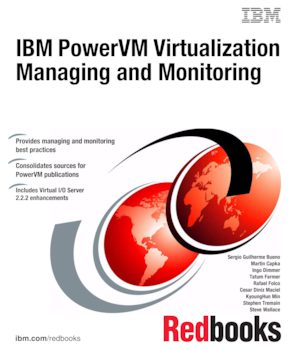
Published on 17 June 2013, updated 30 June 2014
Share this page:
ISBN-10: 0738438162
ISBN-13: 9780738438160
IBM Form #: SG24-7590-04
Authors: Scott Vetter, Sergio Guilherme Bueno, Martin Capka, Ingo Dimmer, Tatum Farmer, Rafael Folco, Cesar Diniz Maciel, KyoungHun Min, Stephen Tremain and Steve Wallace
Abstract
IBM® PowerVM® virtualization technology is a combination of hardware and software that supports and manages the virtual environments on POWER5-, POWER5+, IBM POWER6®, and IBM POWER7®-based systems.
PowerVM is available on IBM Power Systems™, and IBM BladeCenter® servers as optional Editions, and is supported by the IBM AIX®, IBM i, and Linux operating systems. You can use this set of comprehensive systems technologies and services to aggregate and manage resources by using a consolidated, logical view. Deploying PowerVM virtualization and IBM Power Systems offers you the following benefits:
- Lower energy costs through server consolidation
- Reduced cost of your existing infrastructure
- Better management of the growth, complexity, and risk of your infrastructure
This IBM Redbooks® publication is an extension of IBM PowerVM Virtualization Introduction and Configuration, SG24-7940. It provides an organized view of best practices for managing and monitoring your PowerVM environment concerning virtualized resources managed by the Virtual I/O Server.
Table of Contents
Chapter 1. PowerVM Introduction
Part 1. Processor Virtualization
Chapter 2. Shared Processor Pool
Chapter 3. Multiple Shared Processor Pools
Chapter 4. POWER processor compatibility modes
Part 2. Memory Virtualization
Chapter 5. Active Memory Sharing
Chapter 6. Active Memory Deduplication
Chapter 7. Active Memory Expansion
Part 3. I/O Virtualization
Chapter 8. Network virtualization
Chapter 9. Storage Virtualization
Chapter 10. Shared storage pools
Part 4. Virtual I/O Server
Chapter 11. Virtual I/O Server
Part 5. Managed Systems Virtualization
Chapter 12. \Dynamic Logical Partitioning
Chapter 13. Partition Suspend and Resume
Chapter 14. Live Partition Mobility
Chapter 15. Dynamic Platform Optimizer
Chapter 16. Active System Optimizer and Dynamic System Optimizer for AIX
Part 6. Enterprise management tools
Chapter 17. IBM Systems Director
Chapter 18. Tivoli Systems Management integration
Part 7. Appendix
Appendix A. AIX disk and NIB network checking and recovery script